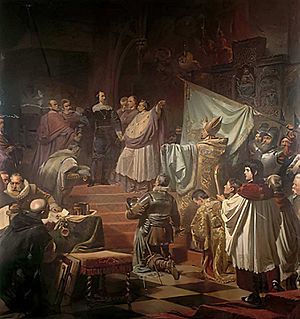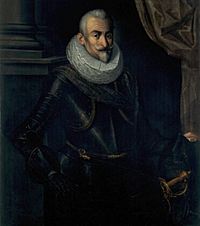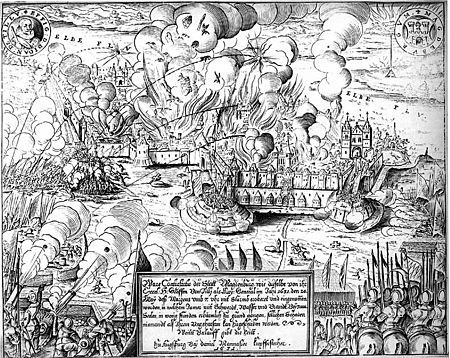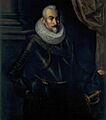Catholic League (German) facts for kids
Quick facts for kids Catholic League |
|
|---|---|
| Katholische Liga (German), Liga Catholica (Latin) Participant in War of the Jülich Succession, Thirty Years' War |
|
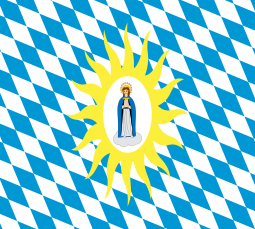
Flag of the Catholic League
|
|
| Active | July 10, 1609 – May 30, 1635 |
| Ideology | Catholicism, Counter-Reformation |
| Allegiance | |
| Founders |
List of founder states
15px|Coat of arms of the Provost of Kempten Kempten 15px|Coat of arms of the Archbishopric of Mainz (1250) Mainz 15px|Coat of arms of the Diocese of Passau Passau 15px|Coat of arms of the Diocese of Speyer Speyer 15px|Coat of arms of the Diocese of Strasbourg Straßburg 15px|Coat of arms of the Archbishopric of Trier Trier 15px|Coat of arms of the Diocese of Worms Worms 15px|Coat of arms of the Diocese of Würzburg Würzburg |
| President |
|
| Military leader | Johann Tserclaes (1610–32) Johann von Aldringen (1632–34) |
| Headquarters | Munich |
| Area of operations | Holy Roman Empire |
| Merged into | Imperial Army |
| Allies | Kingdom of Spain |
| Opponents | Protestant Union Bohemian Estates Electoral Palatinate Kingdom of Denmark Kingdom of Sweden |
| Battles and wars |
|
The Catholic League (also known as Liga Catholica in Latin or Katholische Liga in German) was a group of Catholic states in the Holy Roman Empire. It was formed on July 10, 1609.
At first, the League was a political group. It aimed to discuss problems with the Protestant Union, which was formed in 1608. The Catholic League was inspired by a similar group in France. Later, it became a military alliance. Its main goal was to protect the Catholic religion and keep peace in the Empire.
Even with the League and the Protestant Union, tensions grew between Catholics and Protestants. These groups had disagreed for a long time since the Protestant Reformation. Things got worse with more arguments and conflicts. This eventually led to the start of the Thirty Years' War about ten years later. A key event that started the war was the Third Defenestration of Prague on May 23, 1618.
Why Was the Catholic League Formed?
The Peace of Augsburg
In 1555, an important agreement called the Peace of Augsburg was signed. This peace treaty ended fighting between Catholics and Lutherans in the Holy Roman Empire.
The Peace of Augsburg stated:
- Princes in the Holy Roman Empire could choose the religion for their own lands. They could pick either Catholicism or Lutheranism. This was known as cuius regio, eius religio (meaning "whose realm, his religion").
- Lutherans living in areas controlled by a Catholic prince-bishop could stay Lutheran.
- Lutherans could keep any church lands they had taken from the Catholic Church since 1552.
- If a Catholic bishop became a Lutheran, they had to give up their land. This rule was called reservatum ecclesiasticum.
- People living in a state had to follow the official religion of that state.
Even though this peace stopped the fighting for a while, the main religious problems were not solved. Both sides understood the agreement in their own way. Lutherans, especially, thought it was only a temporary deal. Also, Calvinism quickly spread in the Empire. This added a third major Christian group, but the Peace of Augsburg did not include Calvinism. Only Catholicism and Lutheranism were allowed.
Reasons for a Catholic Alliance
Donauwörth Incidents
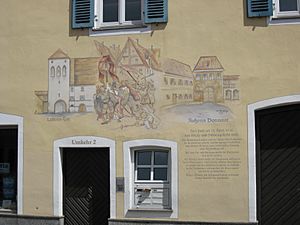
A major reason for forming the Catholic League was an event in Donauwörth. This was a free city within Bavaria. On April 25, 1606, most people in Donauwörth were Lutheran. They stopped the Catholic residents from holding their yearly Markus procession. This procession was a way for Catholics to show their faith in the town.
The Catholics, led by five monks, wanted to walk through the town to a nearby village. They wanted to carry their flags and sing hymns. The Peace of Augsburg allowed them to do this. However, the city council would only let them back into town without flags and singing. This led to a fight.
The bishop of Augsburg complained to the Catholic Emperor Rudolf II. The Emperor threatened to punish the town if they broke Catholic rights again. The next year, similar anti-Catholic events happened. The people in the Markus procession were forced out of town.
Emperor Rudolf then declared a ban on Donauwörth. He ordered Maximilian I, Duke of Bavaria to enforce it. The town surrendered when Maximilian's army arrived. According to Imperial law, a Protestant duke should have handled this, not the Catholic Duke of Bavaria. Maximilian also took control of Donauwörth, which was against Imperial law.
Protestant Union Forms
In 1607, the Catholic majority in the Imperial assembly (Reichstag) decided something important. They said the Peace of Augsburg could only be renewed if all church land taken since 1552 was returned. Because of these events, the Protestant princes created a military alliance. This was the Protestant Union, formed on May 14, 1608. Its leader was Frederick IV, Elector Palatine.
Starting the Catholic League
To balance the Protestant Union, Maximilian began talking with other Catholic princes in early 1608. By July 5, 1608, Catholic leaders wanted to form a group like Maximilian suggested. They even discussed how big their combined army should be.
Munich Meeting
In July 1609, leaders from several Catholic areas met in Munich. These included Augsburg, Constance, Passau, Regensburg, and Würzburg. On July 10, 1609, these states formed an alliance. Its goal was "to defend the Catholic religion and peace within the Empire."
A key rule of the League was that members could not attack each other. Instead of fighting, they had to solve problems using Imperial laws. If that failed, they would use arbitration within the League. If one member was attacked, others had to help with soldiers or legal support. Duke Maximilian was chosen as the president. The bishops of Augsburg, Passau, and Würzburg were his advisors. The League was planned to last for nine years.
The Munich meeting did not create a strong structure for the new League. On June 18, 1609, the Electors of Mainz, Cologne, and Trier suggested an army of 20,000 men. They also thought Maximilian should be president. On August 30, they agreed to join the Munich plan. But they wanted the Elector of Mainz to be a co-president.
Würzburg Meeting
To build a better structure, several general meetings were planned. On February 10, 1610, representatives from all major Catholic states met in Würzburg. Austria and Salzburg were not there. Many smaller states also attended. They met to decide how the League would be organized, funded, and armed. This meeting was the true beginning of the Catholic League. The Pope, the Emperor, and the King of Spain all supported the idea.
The League's main problem was that its members were not ready. By April 1610, not all members had paid their contributions. Maximilian threatened to quit. To stop him, Spain promised money even without Austria joining. The Pope also promised more support.
Years Before the War
Jülich Succession Conflict
The actions of the Protestant Union in the Jülich dispute and their military moves in Alsace made a fight between the League and the Union seem very likely.
Habsburgs Join
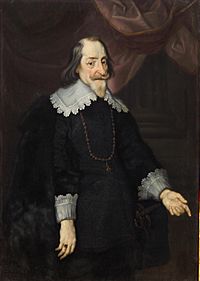
In 1613, the Austrian Habsburgs joined the League at Regensburg. The assembly then chose three war leaders: Duke Maximilian, and Archdukes Albert and Maximilian of Austria. The League's goal was now called "a Christian legal defense."
When the Habsburg monarchy joined, the League became part of the struggles between the Emperor and his Protestant subjects. These struggles in Bohemia and Lower Austria would soon lead to the Thirty Years' War. In the first half of the war, the Emperor used the Catholic League's forces as the most important part of his army.
Bavaria Leaves (Temporarily)
Duke Maximilian did not agree with some decisions made at Regensburg. He even quit his role as president. This happened when Archduke Maximilian III of Austria and the Prince Electors of Mainz and Trier protested. They did not like the inclusion of the Bishop of Augsburg and the Provost of Ellwangen in the Bavarian leadership. So, on May 27, 1617, Bavaria formed its own separate league for nine years. It included the Prince-Bishops of Bamberg, Eichstädt, Würzburg, and the Prince-Provost of Ellwangen.
Bohemian Revolt
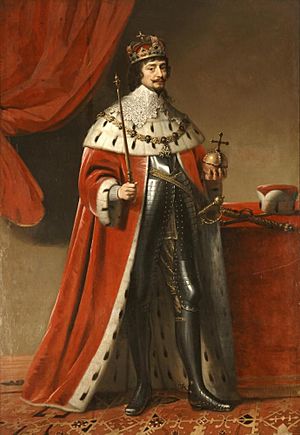
Ferdinand II had been crowned King of Bohemia in 1617. But in 1618, rebellious Protestant Czech nobles removed him and his Catholic governors. This event was called the Second Defenestration of Prague. The Bohemian nobles then chose Frederick V, Elector Palatine as their new king on August 26 and 27, 1619. After Ferdinand was elected German Emperor on August 28, he talked with the Catholic electors in Frankfurt. He asked for the League's support.
Catholic League Reestablished
By late 1618, the Emperor's position in Bohemia and Austria was becoming very difficult. He needed help, so he tried to bring the League back together. Several Catholic princes met and decided to rebuild the League based on its original plan. It would have two main parts:
- The Rhenish district, led by Mainz.
- The Oberland district, led by Bavaria.
The money and military command would be separate. Maximilian would only lead all the troops if they had to fight in the Rhenish district. On May 31, both groups were set up. They promised to help each other for six years.
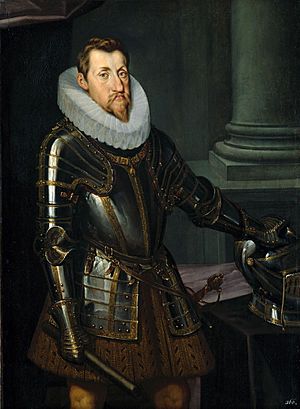
Treaty of Munich
The Treaty of Munich was signed on October 8, 1619. It was between Emperor Ferdinand II and Duke Maximilian of Bavaria. A Spanish ambassador convinced Ferdinand to let Maximilian take over parts of the Electoral Palatinate. Maximilian would also get the electoral seat of Frederick V. The ambassador also promised Ferdinand that Spain would help against the Bohemian rebels. Because of this treaty, Maximilian, the leader of the Catholic League, offered his Bavarian forces to Emperor Ferdinand.
Now, a combined army began to form. Bavaria provided the most soldiers, about 7,000 men. In December 1619, in Würzburg, the army's total strength was set at 21,000 foot soldiers and 4,000 horsemen. The main commander was Johann Tserclaes, Count of Tilly.
Protestant Union's End
The League's army had 30,000 men, while the Protestant Union had only 10,000. Facing this larger force, the Protestant Union agreed to stop all fighting during the war in Austria and Bohemia. This was part of the Treaty of Ulm on July 3, 1620. The Union then broke up the following year.
The League in War
Bohemian Campaign

With no threat from the Protestant Union, the League could use all its soldiers to help the Emperor. In the same month, the army moved to Upper Austria. Tilly won the Battle of White Mountain near Prague on November 8, 1620. In this battle, half of the enemy soldiers were killed or captured. The League lost only 700 men. The Emperor regained control of Bohemia. This marked the end of the League's first major action in the Thirty Years' War.
Palatinate Campaigns
1622 Campaign
In the spring of 1622, General Tilly led the League's army to attack the Electoral Palatinate. They were defeated by General Mansfeld's troops at the Battle of Mingolsheim on April 27, 1622. As they retreated east, a Spanish army joined them. When another Protestant army attacked on May 6, Tilly's League forces won the Battle of Wimpfen clearly, scattering the enemy. The Battle of Höchst on June 20 was the most important victory of 1622.
After that battle, the Protestant forces fighting for Frederick V of the Palatinate moved across the Rhine River. This allowed the Catholic League army to move freely. Tilly then captured Heidelberg, Frederick's main city, after an eleven-week siege on September 19. Mannheim fell on November 2, after a ten-day siege.
This could have ended the war. Except for the fortress of Frankenthal, the Electoral Palatinate was controlled by League forces. Count Frederick was in exile in the Netherlands.
Stadtlohn Campaign
However, in 1623, Frederick had Christian of Brunswick raise another army to keep fighting. But Christian had little success and found no allies. When Tilly's League army approached, the Protestants headed for the Dutch border. Tilly cut them off five miles short of it in the Battle of Stadtlohn on August 6. He destroyed another Protestant army.
This victory ended the "Bohemian-Palatinate phase" of the war. Armed resistance against the Emperor and his anti-Protestant policies stopped.
Danish War
This led Denmark's king Christian IV to join the Thirty Years' War in 1625. He wanted to protect Protestantism and become the main leader of Northern Europe.
The League's army fought and defeated the Danish forces on August 26–27, 1626, at the Battle of Lutter. More than half of the fleeing Danish army was destroyed. Because of this and other victories, Denmark had to ask for peace at the Treaty of Lübeck.
Edict of Restitution
Supported by the Catholic princes and their winning League army, the Emperor now declared Protestantism illegal in many parts of Northern Germany.
In March 1629, Emperor Ferdinand II issued the Edict of Restitution. This law aimed to return the situation to how it was in 1555, based on the Peace of Augsburg. It focused on church lands that had become Protestant in the decades since then.
Bremen and Magdeburg were major examples of lands to be returned. Protestant leaders there feared the Catholic League's army would enforce this new law. So, they looked for allies abroad to protect them.
Swedish War
Sack of Magdeburg
While the Swedish King Gustavus Adolphus landed his army in Pomerania, the League's army besieged Magdeburg. The city had promised to support Sweden. The siege lasted two months, from March 20, 1631. On May 20, 40,000 soldiers successfully attacked Magdeburg. A terrible massacre of the people followed. About 25,000 of the city's 30,000 inhabitants died. Fires also destroyed much of the city.
The Catholic League's Defeat
In 1630, Ferdinand II removed his main general, Wallenstein. Now, the Catholic League controlled all Catholic armed forces.
At the First Battle of Breitenfeld, the Catholic League, led by General Tilly, was defeated by the Swedish forces. A year later (1632), they met again in the Battle of Rain. This time, General Tilly was killed. The advantage had now shifted from the League to Sweden and its allies. They were able to attack and capture or destroy the Catholic League's lands. Even Munich, the capital of the most powerful member state, Electoral Bavaria, was conquered.
Decline and End
After these events, the German Catholic League did not play a major role in the rest of the war.
The Peace of Prague was signed on May 30, 1635. This treaty was between the Holy Roman Emperor, Ferdinand II, and most of the Protestant states in the Empire. It effectively ended the civil war part of the Thirty Years' War. The Edict of Restitution of 1629 was canceled. The rules of the Peace of Augsburg from 1555 were put back in place.
One of the most important rules was that formal alliances between states of the Empire were forbidden. The armies of the different states were to join with the Emperor's army. This meant the end of the Catholic League, as it was now a forbidden alliance between states.
Besides ending the fighting, the treaty also stopped religion from being a cause of conflict between states. The idea of cuius regio, eius religio was firmly established in the Empire.
Images for kids
-
Maximilian I, Duke of Bavaria
-
Frederick V of the Palatinate as King of Bohemia
-
Ferdinand II, Holy Roman Emperor in armor
-
Battle of White Mountain, painted by P. Snayers
See also
 In Spanish: Liga Católica (1609) para niños
In Spanish: Liga Católica (1609) para niños


